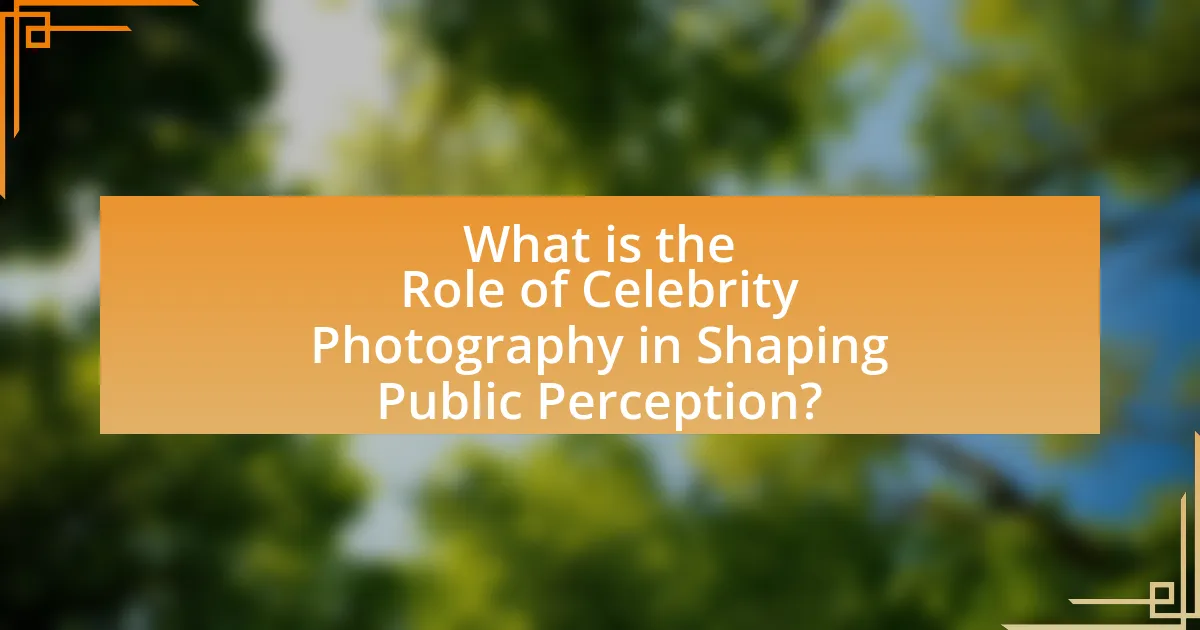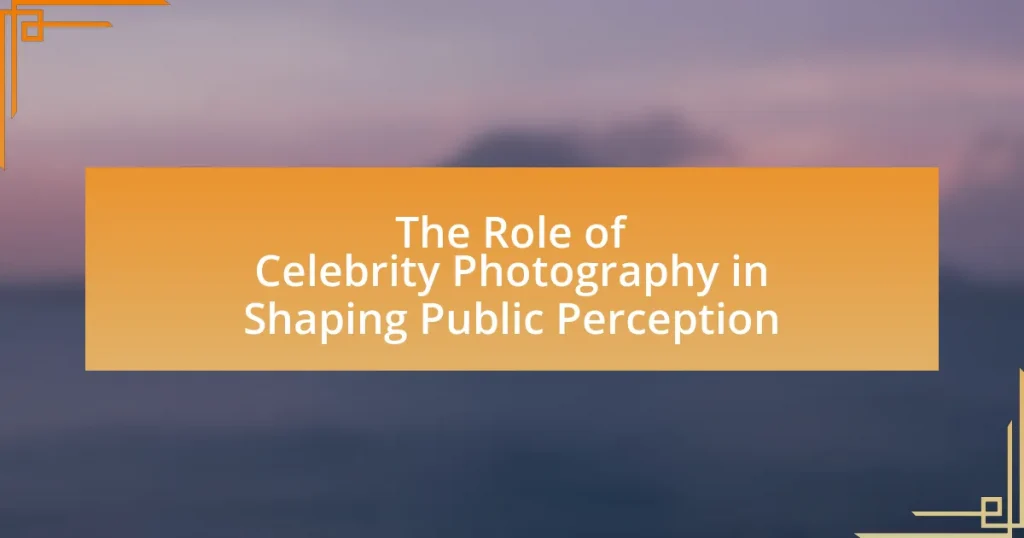Celebrity photography plays a pivotal role in shaping public perception by influencing societal norms related to beauty, lifestyle, and success. The article explores how curated images of celebrities create aspirational standards that can lead to body dissatisfaction and altered self-esteem, particularly among young women. It examines the psychological effects of celebrity imagery on audience behavior, the ethical considerations surrounding privacy and consent, and the impact of social media on the dissemination of these images. Additionally, the article discusses current trends in celebrity photography, including the rise of candid and unfiltered images, and how influencers are changing the landscape by prioritizing authenticity over traditional glamour.

What is the Role of Celebrity Photography in Shaping Public Perception?
Celebrity photography plays a crucial role in shaping public perception by influencing societal norms and ideals. Through carefully curated images, celebrity photography creates aspirational standards related to beauty, lifestyle, and success, which can significantly impact audience behavior and attitudes. For instance, studies have shown that exposure to idealized images of celebrities can lead to increased body dissatisfaction among viewers, particularly among young women, as evidenced by research published in the journal “Body Image” by Tiggemann and Slater (2014). This demonstrates that the portrayal of celebrities in photography not only reflects but also actively constructs public perceptions, reinforcing specific cultural narratives and expectations.
How does celebrity photography influence societal views?
Celebrity photography significantly influences societal views by shaping perceptions of beauty, lifestyle, and social norms. The images of celebrities often set trends and establish ideals that the public aspires to, impacting self-image and behavior. For instance, studies have shown that exposure to idealized images can lead to increased body dissatisfaction among individuals, particularly young women, as evidenced by research published in the journal “Body Image,” which found a correlation between celebrity images and negative self-perception. Additionally, celebrity photography can also affect societal attitudes towards various issues, such as mental health and diversity, as seen when celebrities use their platforms to advocate for change, thereby normalizing discussions around these topics.
What psychological effects does celebrity imagery have on the audience?
Celebrity imagery significantly influences audience perceptions and behaviors, often leading to idealization and aspiration. This effect occurs as individuals frequently compare themselves to the glamorous lifestyles portrayed by celebrities, which can result in feelings of inadequacy or low self-esteem when they perceive a gap between their own lives and the idealized images. Research indicates that exposure to celebrity imagery can also foster a desire for materialism and consumerism, as audiences may associate happiness and success with the products endorsed by these figures. For instance, a study published in the Journal of Consumer Research found that individuals exposed to aspirational celebrity images were more likely to express a desire for luxury goods, highlighting the direct psychological impact of such imagery on consumer behavior.
How do public figures utilize photography to craft their image?
Public figures utilize photography to craft their image by strategically selecting visuals that convey desired narratives and emotions. This approach allows them to control public perception, as images can evoke specific feelings and associations. For instance, celebrities often use professional photography to present an idealized version of themselves, showcasing glamour, success, and relatability. Research indicates that images shared on social media platforms can significantly influence audience engagement and perception, with studies showing that visually appealing content garners more attention and positive reactions. By curating their photographic representation, public figures effectively shape how they are viewed by the public, reinforcing their brand and personal identity.
Why is celebrity photography significant in modern media?
Celebrity photography is significant in modern media because it shapes public perception and influences societal norms. This form of visual storytelling provides insight into the lives of public figures, creating a connection between celebrities and their audience. Research indicates that images of celebrities can affect consumer behavior, with studies showing that 70% of consumers are more likely to purchase products endorsed by celebrities they admire. Furthermore, celebrity photography plays a crucial role in setting trends and cultural standards, as seen in fashion and lifestyle industries, where visual representation can drive public interest and engagement.
What role does social media play in the dissemination of celebrity images?
Social media serves as a primary platform for the rapid dissemination of celebrity images, significantly influencing public perception. Through platforms like Instagram, Twitter, and Facebook, celebrities share personal moments, professional milestones, and curated images directly with their audience, bypassing traditional media filters. This direct engagement allows for real-time interaction and fosters a sense of intimacy between celebrities and their fans. According to a 2021 study published in the Journal of Communication, 70% of respondents reported that they feel more connected to celebrities through social media, which enhances the impact of the images shared. Thus, social media not only amplifies the reach of celebrity images but also shapes how the public perceives and interacts with these figures.
How has the evolution of technology impacted celebrity photography?
The evolution of technology has significantly transformed celebrity photography by enhancing accessibility, immediacy, and the quality of images captured. With the advent of smartphones equipped with high-resolution cameras, everyday individuals can now take and share photographs of celebrities, democratizing the field and increasing the volume of images available to the public. Additionally, social media platforms like Instagram and Twitter allow for real-time sharing, enabling fans to engage with celebrity moments as they happen, which shapes public perception instantaneously. The rise of digital editing tools has also allowed photographers to manipulate images more easily, influencing how celebrities are portrayed and perceived. For instance, the use of filters and retouching software can create idealized representations that impact audience expectations and perceptions of celebrity lifestyles.
What are the ethical considerations in celebrity photography?
Ethical considerations in celebrity photography include respect for privacy, consent, and the potential for harm. Photographers must navigate the balance between public interest and an individual’s right to privacy, as celebrities are entitled to personal space despite their public status. Consent is crucial; capturing images without permission can lead to legal repercussions and ethical dilemmas. Additionally, the portrayal of celebrities can influence public perception, potentially leading to misrepresentation or exploitation. For instance, sensationalized images can perpetuate harmful stereotypes or contribute to mental health issues among the subjects. These considerations highlight the responsibility of photographers to act ethically while fulfilling their role in shaping public perception.
How do privacy concerns affect the practice of celebrity photography?
Privacy concerns significantly impact the practice of celebrity photography by limiting the extent to which photographers can capture images of public figures in private settings. Legal frameworks, such as California’s “anti-paparazzi” laws, restrict intrusive photography, particularly in situations where celebrities expect privacy, like their homes or during personal moments. These regulations aim to balance the public’s interest in celebrity culture with the individual’s right to privacy, leading to a more cautious approach among photographers. Consequently, many photographers now focus on public appearances or events, where the expectation of privacy is lower, thereby shaping the narrative and public perception of celebrities in a more controlled manner.
What responsibilities do photographers have towards their subjects?
Photographers have the responsibility to respect the dignity and privacy of their subjects. This includes obtaining informed consent before capturing images, ensuring that subjects are comfortable with how their likeness will be used, and being sensitive to the context in which the photographs are taken. For instance, ethical guidelines in photography emphasize the importance of portraying subjects accurately and avoiding manipulation that could misrepresent them. Additionally, photographers should consider the potential impact of their work on the subjects’ reputations and personal lives, as celebrity photography can significantly influence public perception.
How does celebrity photography affect public perception of beauty standards?
Celebrity photography significantly influences public perception of beauty standards by promoting idealized images that often set unattainable benchmarks for attractiveness. Research indicates that exposure to such images can lead to body dissatisfaction and altered self-esteem among viewers, particularly among young women. A study published in the journal “Body Image” found that individuals who frequently consume celebrity images are more likely to internalize these beauty ideals, resulting in negative body image and increased pressure to conform to these standards. This phenomenon underscores the powerful role that celebrity photography plays in shaping societal norms regarding beauty.
What impact does edited imagery have on audience self-esteem?
Edited imagery negatively impacts audience self-esteem by creating unrealistic beauty standards. Research indicates that exposure to heavily edited images can lead to body dissatisfaction and lower self-worth among viewers. A study published in the journal “Body Image” found that individuals who frequently engage with idealized images report higher levels of negative body image and lower self-esteem. This correlation suggests that the portrayal of unattainable beauty in edited imagery contributes to a distorted self-perception among audiences.
How do different cultures interpret celebrity images?
Different cultures interpret celebrity images through their unique social norms, values, and historical contexts. For instance, in Western cultures, celebrity images often symbolize success and aspiration, leading to idolization and consumerism, as evidenced by the prevalence of celebrity endorsements in advertising. Conversely, in many Eastern cultures, celebrity images may be viewed through a lens of collectivism, where the focus is on the celebrity’s role within society rather than individual achievement, reflecting cultural values that prioritize community over personal success. Research by the Pew Research Center indicates that cultural background significantly influences how individuals perceive and engage with celebrity culture, highlighting the diverse interpretations across global contexts.
What are the trends in celebrity photography today?
Current trends in celebrity photography include the rise of candid and unfiltered images, a focus on authenticity, and the use of social media platforms for real-time sharing. Candid photography captures celebrities in natural settings, moving away from posed and heavily edited images, which resonates with audiences seeking genuine connections. The emphasis on authenticity is supported by the popularity of platforms like Instagram, where celebrities share behind-the-scenes moments, fostering relatability. Additionally, the integration of video content, such as Instagram Stories and TikTok, has transformed how celebrity moments are captured and consumed, allowing for dynamic storytelling. These trends reflect a shift in public perception, as audiences increasingly value transparency and real-life portrayals over traditional glamour shots.
How are influencers changing the landscape of celebrity photography?
Influencers are transforming the landscape of celebrity photography by democratizing access to visual content and shifting the focus from traditional media to personal branding. Unlike conventional celebrity photography, which often relies on professional photographers and curated images, influencers utilize platforms like Instagram to share candid, relatable moments directly with their audience. This shift has led to a more intimate portrayal of celebrities, where authenticity and personal connection are prioritized over polished images.
Research indicates that 70% of millennials trust influencers more than traditional celebrities, highlighting the impact of this change on public perception. As a result, brands are increasingly collaborating with influencers for marketing campaigns, further blurring the lines between celebrity and influencer photography. This evolution reflects a broader trend where the audience seeks genuine engagement, reshaping how celebrity images are created and consumed.
What styles of photography are currently popular among celebrities?
Currently, candid and lifestyle photography styles are popular among celebrities. These styles emphasize authenticity and relatability, allowing celebrities to connect with their audience on a personal level. For instance, many celebrities share unfiltered moments from their daily lives on social media platforms, showcasing a more genuine side that contrasts with traditional posed photography. This trend is supported by the rise of platforms like Instagram, where over 1 billion users engage with visual content, highlighting the demand for more intimate and spontaneous imagery.
What practical tips can be applied to understand celebrity photography’s impact?
To understand celebrity photography’s impact, analyze the visual narratives created by images and their emotional resonance with audiences. Examining how lighting, composition, and context influence public perception reveals the strategic choices photographers make to shape celebrity personas. Research indicates that images can evoke specific emotions, with studies showing that well-composed photographs can significantly alter viewer attitudes towards the subject. For instance, a study published in the Journal of Visual Culture highlights that celebrity images can reinforce societal ideals, affecting public opinion and behavior.



